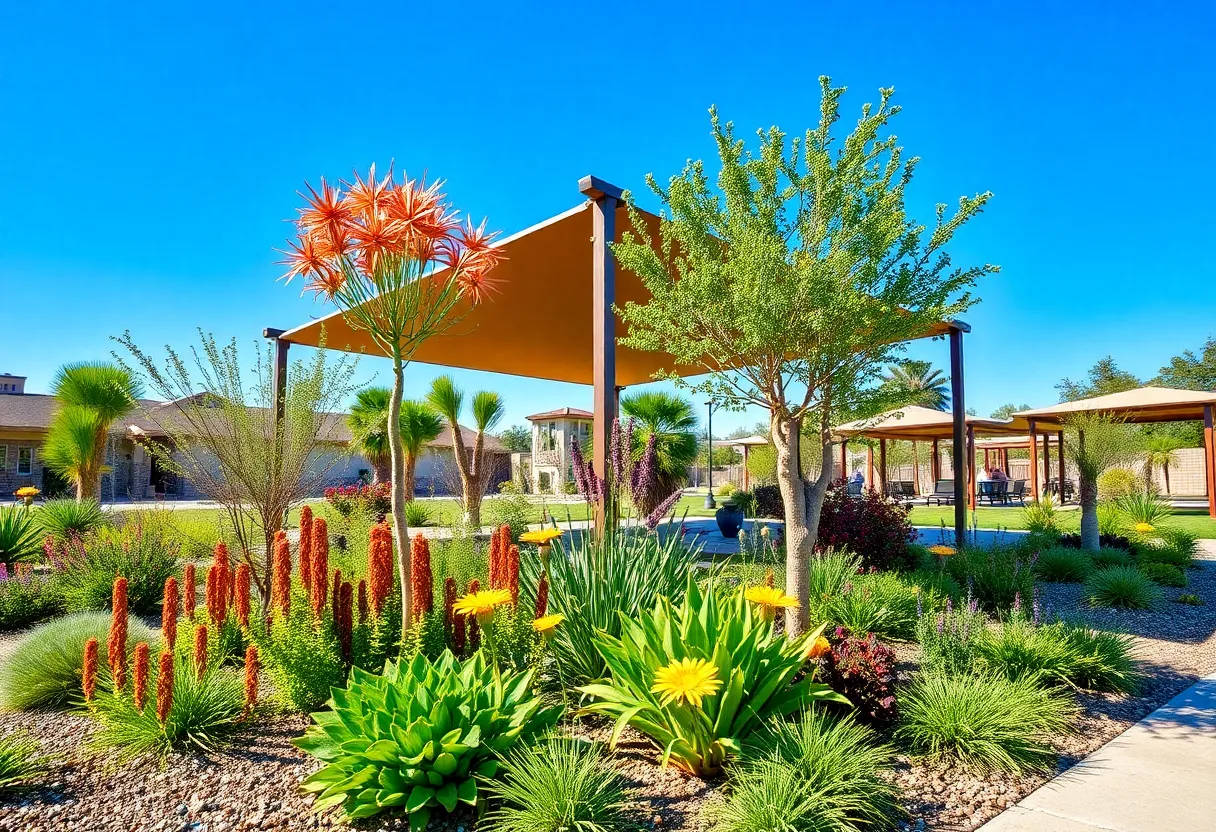5 Must-Know Tips for Designing a Stunning Landscape in Houston’s Heat
Designing an attractive and durable landscape in Houston’s environment requires deliberate choices rooted in understanding the region’s climate. High temperatures, humidity, and unpredictable weather patterns demand strategies that prioritize resilience without compromising appeal. Implementing these five vital tips ensures your outdoor space remains vibrant, sustainable, and comfortable throughout the year.
1. Select Heat-Tolerant and Native Plants
The foundation of a successful Houston landscape begins with selecting appropriate plant species. Use native plants extensively—they are naturally adapted to the local climate, requiring less water, fertilizers, and pest management. This approach enhances sustainability and simplifies maintenance.
Heat-tolerant plants have evolved mechanisms to withstand prolonged periods of high temperatures and humidity. Incorporating a variety of these species results in a diverse, resilient garden that maintains visual interest.
Recommended Native and Heat-Resistant Plants
- Creeping Juniper: An evergreen ground cover that provides year-round greenery. Its drought resistance makes it ideal for erosion control on slopes.
- Bugleweed (Ajuga): Offers glossy foliage and vibrant blue-purple flowers in spring. Suitable for shaded areas or woodland garden themes.
- Creeping Thyme: Fragrant, low-growing, and tolerant of drought; perfect for pathways or as a turf substitute.
- Liriope (Monkey Grass): Maintains its grass-like appearance all year, thriving in shaded or partly shaded locations.
- Stonecrop (Sedum): Drought-tolerant succulent well-suited for rock gardens and xeriscapes, adding texture and color.
Careful selection of these plants can significantly reduce water usage and maintenance efforts while maintaining aesthetic appeal. Combining these options in layered ways creates a landscape that is both lively and sustainable.
2. Implement Efficient Irrigation Systems
In climates with high heat, effective watering strategies are essential. Traditional sprinklers often lead to water waste and uneven distribution. Modern irrigation solutions focus on precision and conservation.
Effective Irrigation Techniques
- Drip Irrigation Systems: These systems deliver water slow and steady directly to the root zones, minimizing evaporation. They are especially effective around delicate plants or in densely planted beds.
- Smart Controllers: Equipped with weather sensors and soil moisture sensors, these devices adapt watering schedules based on real-time conditions. They prevent over- or under-watering, conserving resources and promoting plant health.
Timing is critical; watering during early mornings or late evenings helps reduce evaporation losses. Frequent monitoring for signs of heat stress—such as wilting, discoloration, or leaf scorch—allows for timely adjustment of watering volumes or methods.
3. Utilize Mulching Techniques
Mulch is a cornerstone for tackling Houston’s heat, offering multiple benefits that support plant health. Proper application of mulch creates a microclimate around roots, reducing heat stress and conserving moisture.
Benefits of Mulching
- Moisture Retention: Mulch reduces evaporation from the soil surface, decreasing irrigation needs and maintaining consistent moisture levels.
- Temperature Regulation: It insulates the soil, keeping root zones cooler during peak heat periods and preventing temperature fluctuations that can stress plants.
- Weed Suppression: A thick layer of mulch inhibits weed seed germination, lowering maintenance and competition for nutrients.
Organic mulches—such as shredded wood, straw, or pine needles—are recommended. Apply a 2-3 inch layer around plant bases, ensuring it does not contact stems or trunks to avoid rot. Replenishing mulch annually or as needed sustains its benefits and keeps the landscape thriving.
4. Incorporate Shade Structures
Shade is critical for reducing heat exposure, making outdoor spaces more comfortable and protecting plants from excessive sun. Proper shade structures enable longer outdoor enjoyment and help prevent plant scorch and dehydration.
Popular Shade Elements
- Pergolas: These customizable structures create shaded zones with aesthetic appeal, often complemented with climbing plants for natural shade and beauty.
- Shade Sails: Made of durable fabric stretched over frames, they offer flexible coverage options over patios, seating areas, or pathways. Their modern look adds visual interest.
- Shade Trees: Planting native species like oaks or maples provides natural, long-term shade. They add height, texture, and ecological benefits to the landscape.
Strategic placement of shade elements reduces ambient temperatures and creates inviting outdoor living zones. They also protect both plants and people from the harshest sun rays, extending the usability of your landscape.
5. Choose Light-Colored Hardscaping Materials
Hardscape elements influence the overall thermal comfort of outdoor spaces. Light-colored materials reflect rather than absorb sunlight, reducing heat buildup and creating cooler environments.
Application of Light-Colored Materials
- Paving and patios: Using light-colored concrete, stone, or tile surfaces lowers surface temperatures, making walkways and seating areas more comfortable.
- Walls and fences: Light-colored finishes reflect heat away, reducing the “heat island” effect common in urban landscapes.
- Furniture: Opt for light-colored or reflective finishes to reduce heat retention, especially on surfaces likely to be touched or used in direct sun exposure.
This approach not only makes outdoor spaces more pleasant but also contributes to energy savings by reducing indoor cooling loads if hardscapes are adjacent to structures.
Conclusion
Designing a landscape suited to Houston’s climate involves selecting heat-tolerant, native plants, employing efficient irrigation, applying mulch properly, integrating shade structures, and utilizing light-colored hardscaping materials. These strategies collectively optimize water use, reduce heat stress, and maintain visual appeal. Implementing them ensures your outdoor space remains durable, comfortable, and attractive despite the challenging heat.
Frequently Asked Questions
How do I choose the best plants for Houston’s heat?
Select native, heat-tolerant plants that are adapted to Houston’s high temperatures and humidity. Focus on species with proven resilience to local conditions, and incorporate a variety for visual and ecological diversity.
What irrigation system is most efficient for Houston’s climate?
Use drip irrigation systems combined with smart controllers that adjust based on weather and soil moisture. This minimizes water waste and ensures consistent hydration where plants need it most.
Why is mulching important in Houston’s heat?
Mulching retains soil moisture, regulates temperature, and suppresses weeds, all of which are critical for protecting plants from extreme heat and reducing maintenance demands.
How can shade be incorporated into a landscape design?
Install shade structures such as pergolas or shade sails, and plant native shade trees. Proper placement creates cooler zones suitable for relaxing and protects plants from sun damage.
How do light-colored hardscapes help in Houston’s heat?
Light-colored materials reflect sunlight instead of absorbing it, which reduces surface and ambient temperatures, increasing comfort and energy efficiency.
Key Features Comparison Chart
| Feature | Description | Benefits |
|---|---|---|
| Heat-Tolerant Plants | Native or specially selected species adapted to local heat and humidity | Less water, fewer pests, reduced maintenance, year-round greenery |
| Efficient Irrigation | Drip systems and smart controllers using minimal water | Resource conservation, healthier plants, lower utility bills |
| Mulching | Organic material applied around plants to retain moisture | Moisture retention, temperature regulation, weed suppression |
| Shade Structures | Pergolas, shade sails, and trees | Comfortable outdoor spaces, protection from sun damage |
| Light-Colored Hardscapes | Use of reflective materials in pavings, walls, furniture | Reduced heat absorption, cooler environments, energy savings |
Author: STAFF HERE HOUSTON TX WRITER
The HOUSTON STAFF WRITER represents the experienced team at HEREHouston.com, your go-to source for actionable local news and information in Houston, Harris County, and beyond. Specializing in "news you can use," we cover essential topics like product reviews for personal and business needs, local business directories, politics, real estate trends, neighborhood insights, and state news affecting the area—with deep expertise drawn from years of dedicated reporting and strong community input, including local press releases and business updates. We deliver top reporting on high-value events such as Houston Livestock Show and Rodeo, Art Car Parade, and Chevron Houston Marathon. Our coverage extends to key organizations like the Greater Houston Partnership and Houston Area Urban League, plus leading businesses in energy and healthcare that power the local economy such as ExxonMobil, Schlumberger, and Houston Methodist. As part of the broader HERE network, including HEREAustinTX.com, HERECollegeStation.com, HEREDallas.com, and HERESanAntonio.com, we provide comprehensive, credible insights into Texas's dynamic landscape.





